Chapter 9: Inspect procedures
Affiliate learning objectives
When you accept completed this chapter you volition be able to:
- Explicate the assertions contained in the financial statements;
- Provide examples of procedures used to audit specific balances;
- Discuss and provide examples of how analytical procedures are used as substantive procedures;
- Apply inspect techniques to pocket-size and non-for-turn a profit organisations; and
- Discuss the bug associated with the audit and review of accounting estimates.
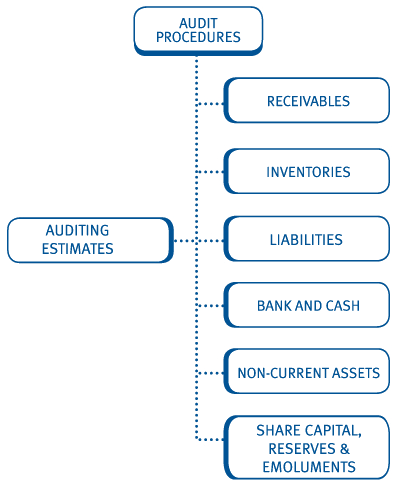
one General principles
We dealt with the principles of audit evidence in an earlier chapter. This chapter deals with the application of those principles.
It is a starting point to assistance you familiarise yourself with the basic auditing techniques to let you to utilize them to questions. It is not an exhaustive summary of all inspect tests, this would simply non be possible in one volume.
2 Fiscal statements assertions
The objective of audit testing is to aid the accountant in coming to a conclusion as to whether the fiscal statements are gratis from material misstatement.
However, the accountant does not merely pattern tests with the wide objective to identify material misstatement. This is a difficult conclusion to reach and tin can only be based upon a serial of detailed tests, each designed with a specific testing objective relating to certain areas of the fiscal statements.
For instance: auditors take to assess whether inventory balances are gratuitous from textile misstatement. Unfortunately, there are many ways inventory could exist misstated:
- items could be missed out of inventory;
- items from the next accounting menstruum could be accidentally included;
- it might not be valued at the lower of toll and net realisable value;
- damaged or obsolete stock might non be identified;
- purchase cost may not be recorded accurately; or
- the stock count may not be performed thoroughly.
Each of these concerns could effect in misstatement, which ultimately could (alone or in aggregate) be textile.
For this reason auditors have to perform a range of tests on the meaning classes of transaction, account balances and disclosures to be reasonably sure that they are non misstated. These tests focus on what are known every bit financial statements assertions:
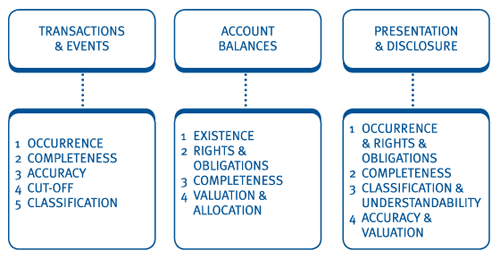
Occurrence â€" did the transactions and events recorded actual occur and pertain to the entity?
Completeness â€" accept all transactions, assets, liabilities and disinterestedness interests been recorded that should accept been recorded?
Accuracy â€" have amounts, data and other information been recorded and disclosed appropriately?
Cut-off â€" have transactions and events been recorded in the right bookkeeping flow?
Classification and understandability â€" have transactions and events been: recorded in the proper accounts; and described and disclosed conspicuously?
Existence â€" do assets, liabilities and equity interests exist?
Rights and obligations â€" does the entity hold or control the rights to assets and are liabilities the obligations of the entity?
Valuation and allocation â€" are avails, liabilities and equity interests included in the fiscal statements at appropriate values?

 Linking assertions to tests
Linking assertions to tests
When the auditor designs further audit procedures they must ensure that they test a range of the assertions listed. For transactions (i.due east. incomes and expenses recorded in the income statement) the auditor should examination:
- occurrence;
- completeness;
- accuracy;
- cutting-off; and
- classification
For accounts balances (i.e. those balances recorded on the statement of fiscal position) the auditor should test:
- existence;
- rights and obligations;
- completeness; and
- valuation and resource allotment.
Whilst the testing of accounts balances and transactions volition probably be the focus of the inspect, the accountant must also design tests to ensure that transactions, balances and other relevant information/matters are appropriately disclosed in the financial statements. Assertions relevant to the disclosures are:
- occurrence;
- rights and obligations;
- abyss;
- classification and understandability; and
- accurateness and valuation.
To assist your studies and simplify this procedure consider the following four questions that an accountant needs to answer when approaching testing:
(1)Should items be in the accounts at all? (occurrence, existence, rights and obligations, cut-off).
(2)Are they included at the right value? (accuracy, valuation).
(iii)Are at that place any more? (completeness).
(4)Are they disclosed properly? (nomenclature, resource allotment, understandability).


 A farther warning
A farther warning
In the sections that follow, we will consider specific audit areas and advise how these are usually tested. You may be tempted to learn these tests and repeat them 'parrot mode' in the examination. This would exist unwise. Audit procedures are designed to reflect the unique risks of an audit and the nature of items and assertions under scrutiny. You must always try and make your answers specific to whatever scenarios presented in the exam. This requires both knowledge and awarding skills.

3 The audit of receivables
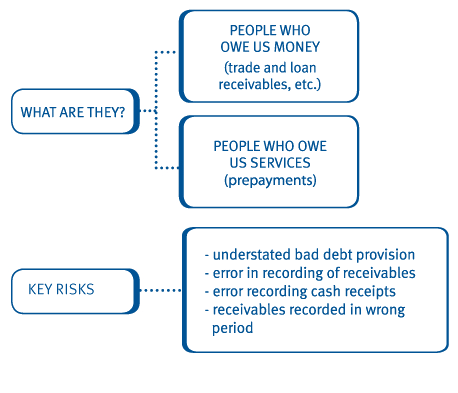
Primal assertions
- Existence â€" the receivable actually exists;
- Rights and obligations â€" the visitor has rights to receive the benefit from receivables;
- Valuation and allocation â€" receivables are included in the financial statements at the correct amount, including provisions for bad and doubtful debt;
- Completeness â€" all receivables relating to the menses have been accounted for; and
- Nomenclature and understandability â€" receivables (including provisions) are appropriately disclosed in the financial statements.
Audit procedures
Existence
- Perform a receivables circularisation ( a direct confirmation from external sources - see below).
- Select a sample of receivables and trace amounts due to the original sales invoice to ostend that a transaction has taken place;
Rights and obligations
- Receivables circularisation;
- Select a sample of receivables and confirm the trade terms to original credit agreements and sales invoices.
Valuation and allocation
- Inspect the ageing profile of receivables to place whatever meaning, long outstanding balances that may require a provision.
- Analytically review the ageing profile in comparison to previous periods to identify any deterioration in credit control.
- Audit postal service year-finish cash book/bank statements and trace payments received to yr-stop receivables to confirm that amounts were indeed collectable.
- Discuss the results of the ageing and cash receipts analysis with direction to identify if any further provisions are required for old, unpaid balances.
- Discuss the assumptions underlying any full general provisions with management to ensure they are advisable.
- Recalculate the provision based on management’s assumptions and agree to the effigy in the fiscal statements.
- Inspect invoices relating to prepaid balances, concord cost to calculations made.
- Inspect banking concern statements to confirm prepaid amounts have been paid.
Completeness
- Obtain a list of receivables balances, cast this and agree information technology to the receivables control account total at the terminate of the year. Differences should be reconciled.
- Perform a receivables circularisation.
- Inspect receivables ledger for credit balances and obtain explanations from management.
- Audit a sample of the concluding v to x goods despatched notes immediately prior to the year-end. Trace these through to year-cease receivables to ensure they have been recorded.
Classification and understandability
- Inspect the typhoon financial statements and agree the receivables figures and disclosures to nominal ledger balances.
 Also annotation the effect of directional testing, e.g. direct testing receivables for overstatement also indirectly tests acquirement for understatement (Dr: Receivables, Cr: Revenue).
Also annotation the effect of directional testing, e.g. direct testing receivables for overstatement also indirectly tests acquirement for understatement (Dr: Receivables, Cr: Revenue).
Receivables circularisations
If successful, circularisations provide testify directly from the receivables themselves. These are considered to exist reliable because they are external, third party confirmations. Circularisations are also written and original.
Procedure
- Select a sample of receivables to be circularised and notify client of those selected;
- Extract details of each receivable from the relevant ledger and prepare letters. This should land the residue outstanding at the year-end and include a answer slip for receivables to ostend the rest;
- Inquire the primary accountant at the client (or other responsible official) to sign the messages;
- The auditor posts or faxes the letters to the private receivables;
- Receivables consummate the respond slips, confirming the amounts they owe the client at the year-end, and post them directly to the auditor; and
- The auditor investigates any disagreement by receivables.
Considerations
Whilst circularisations are undoubtedly a useful and efficient tool for providing good quality evidence, their success does depend on response rates. It must be remembered that the inspect client'south customers are under no obligation to reply and, for this reason, responses may be limited. If the response rate is poor then other forms of evidence must be sought. To maximise the response rate auditors should ensure:
- Letters are sent out every bit shortly every bit possible after the twelvemonth-stop;
- That the outstanding balance is conspicuously displayed and all that receivables have to practice is confirm whether this is right or not;
- A reply slip is attached to minimise the work of the receivable; and
- Pre-paid return envelopes are supplied.

 Case confirmation letter
Case confirmation letter
Customer Ltd
Customer’southward accost
Date of circularisation
Dear Sirs
Equally function of their normal audit procedures we have been requested past our auditors, Auditor & Co, to ask you to confirm the balance on your account with us at 31 Dec 2009, our yr-stop.
The residue on your business relationship, as shown by our records, is shown below. Afterwards comparing this with your records will you please be kind enough to sign the confirmation and return a copy to the auditor in the prepaid envelope enclosed. If the balance is not in agreement with your records, will you delight note the items making up the departure in the space provided.
Delight note that this request is made for audit purposes only and has no further significance.
Your kind co-operation in this thing will exist profoundly appreciated.
Yours faithfully

Accountant & Co
Auditor’s address
Honey Sirs
Nosotros confirm that, except as noted below×, a balance of $10,000 was owing by us to Customer Limited at 31 December 2009.
(infinite for customer'south signature)
×Details of differences:

four The audit of inventories

Key assertions
- Existence â€" does the inventory recorded really exist?
- Completeness â€" accept all inventory balances been recorded?
- Rights and obligations â€" does the company have the rights to receive the benefits from inventories?
- Valuation and allotment â€" are inventories valued accordingly (i.e. at the lower of cost and net realisable value and net of any provisions for damaged and dull moving goods)?
- Cut-off â€" are inventory movements effectually the year-cease recorded in the correct menses?
- Classification and understandability â€" are inventories (including provisions) appropriately disclosed in the financial statements?
The inventory count
Principles
- A typical inventory count happens at the year-end, although continuous counting is possible throughout the twelvemonth.
- The purpose of the count is to confirm that the quantities of inventory recorded on the customer's system are accurate.
- Whilst the count is beingness performed items that are damaged and/or obsolete should be identified for either scrapping or auction at a discounted cost.
- From an inspect perspective, attendance at the count helps provide show regarding the existence, completeness and valuation of inventory balances.
- Inventory counting is the responsibility of the customer. The auditor merely attends the count to help gather evidence to grade an opinion regarding whether inventory is free from textile misstatement or not.
Inventory counting procedures
Earlier the count
- Obtain the client's counting instructions and review them for obvious flaws in the counting process. This may besides aid place if in that location are whatever pregnant or risky elements of inventory that require special attention, or fifty-fifty precautions.
During the count
- Observe the count as it proceeds to ensure:
- the counting instructions are being followed
- all items are being counted and recorded
- there is no risk of double counting
- bear witness of damaged or wearisome moving goods is being recorded
- deliveries and despatches are not being made during the count
- count recording sheets are existence properly controlled (i.eastward. pre-numbered and filled in with ink).
- Carry exam counts, on a suitable sample selection ground, as follows:
- select a sample of items from the inventory records and physically observe the items on the warehouse floor to show the items exist.
- select a sample of physical items from the warehouse flooring and trace them to the inventory records to ensure that the latter is consummate.
- Tape cut-off information by obtaining details of the concluding deliveries and despatches prior to the year-terminate. These will then be traced to inventory records during final audit procedures.
Continuous inventory systems
The procedures suggested above utilise to all inventory counts, whether as a i-off, year-end exercise or where inventory is counted on a rolling basis throughout the yr. The objective is the aforementioned:
- To identify whether the customer's inventory organization reliably records, measures and reports inventory balances.
Where the customer uses a continuous counting system lines of inventory are counted periodically (say monthly) throughout the year and then that by the end of the twelvemonth all lines have been reviewed. There are both advantages and disadvantages of this for the auditor.
Advantages
- The auditor is less time constrained and can pick and choose particular locations and inventory lines to count at whatsoever time to ensure the system is reliable.
- Slow moving and damaged inventory should be identified and adjusted for in the client'due south records on a continuous basis therefore, thus improving the valuation at the yr-cease.
Disadvantages
- The auditor will demand to proceeds sufficient evidence that the system operates effectively at all times, not just at the time of the count.
- Additional procedures will need to be devised to ensure that the year-terminate inventory total is reliable, particularly with regard to cut-off and year-end provisions/estimates.
Inventory held at third parties
- Where the client has inventory at locations non visited past the auditor, the accountant normally obtains confirmation of the quantities, value and condition from the holder. The auditor needs to consider whether the holder is sufficiently contained to exist able to provide relevant, reliable evidence.
- As with confirmations from receivables, the auditor requests details from the party holding the inventory on behalf of the customer to confirm its beingness.
- The confirmation request will exist sent by the customer to those parties identified by the auditor.
- The reply should be sent directly to the auditor to prevent it being tampered with by the client.
- Problems tin occur if the third party uses a different description to that of the client and equally ever, a response is not guaranteed.
Final audit procedures
Completeness
- Obtain an inventory list showing each line of inventory categorised betwixt finished goods, WIP and raw materials. Cast the list to ensure it is arithmetically correct. Brand sure the totals concur to amounts disclosed in the financial statements.
- Trace the items counted during the inventory count to the final inventory listing to ensure it is the aforementioned as the one used at the year-end and to ensure that whatever errors identified during counting procedures have been rectified.
Cut-off
- Trace the GRN'due south from immediately prior to the yr-end (identified during the count) to year-end payables and inventory balances.
- Trace the GDN's from immediately prior to the twelvemonth-end (identified during the count) to the nominal ledgers to ensure the items were removed from inventory prior to the year-stop and have been recorded in receivables prior to the year-cease.
Presentation and disclosure
- Inspect the fiscal statements and ensure that the figures disclosed agree to the audited nominal ledger balances and that inventories have been correctly analysed betwixt finished goods, raw materials and work in progress.
Valuation
- Trace a sample of inventory items back to original purchase invoices to concord their toll.
- Trace a sample of inventory items to post-year-end sales invoices to make up one's mind if the appropriate cost or net realisable value has been used.
- Audit the ageing of inventory items to identify any old/slow moving amounts that may require provision.
- Trace the above items to any inventory provisions and, if they accept non been provided, discuss the reason with management.
- Recalculation of work in progress and finished goods using payroll records for labour costs and utility bills for overhead assimilation.
- Summate inventory turnover/days and compare to terminal year to assess whether inventory is being held longer and therefore requires greater provisions.
- Calculate gross profit per centum and compare to prior year to place any significant fluctuations that may indicate either fault or changes in inventory holding policies.
five The audit of payables, accruals, provisions and contingent liabilities
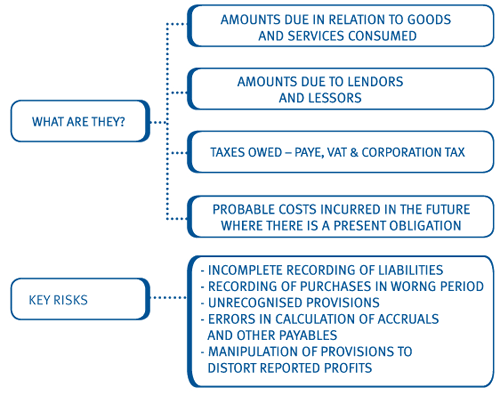
Key assertions
- Existence â€" the payables actually exist;
- Rights and obligations â€" the company has obligations to settle all payables;
- Valuation and allocation â€" payables are included in the financial statements at the correct amount;
- Abyss â€" all payables relating to the menstruation accept been accounted for.
- Classification and understandability â€" all payables are accordingly disclosed in the financial statements.
Completeness is usually the key consideration when testing payables due to the timing and nature of the items included. Provisions and accruals accounting exercise offer an opportunity for creative accounting to manipulate reported profits. Auditors therefore accept to consider indicators that boosted liabilities may exist, such as:
- payables not including known major suppliers and those accrued for in the prior year;
- payables not including the significant suppliers from the equivalent list last twelvemonth;
- traditionally recurring accruals not being fabricated, east.g.: rent, utilities, telephone, etc.
- expected finance accruals not being fabricated, e.g.: hire buy, mortgages, loans etc.
- non-provision of taxation balances, including: corporation tax, payroll taxes, sales taxes, etc.
- suppliers revealed only after a review of payments later the year-end; and
- suppliers revealed by a review of unpaid invoices at and later on the year-stop.
Classification and understandability
- Audit fiscal statements to ensure that all liabilities from the nominal ledger have been adequately and accurately disclosed.
Existence
- Circularise a sample of merchandise payables to confirm the rest at the end of the year (this is uncommon and would only be performed in the absence of supplier statements).
- Inspect year-end statements of accounts sent by suppliers. Any differences between the statement and the nominal ledger should exist reconciled.
- Trace a sample of payable/accruals balances to purchase invoices and/or contracts. In particular identify the engagement of receipt of the invoice and any show of payment (such as signatures).
Abyss
- Cast the payables ledger to ensure its accuracy.
- Audit year-cease statements of accounts sent by suppliers. Any differences betwixt the statement and the nominal ledger should be reconciled.
- Investigate any major (by value of purchases in the year) or known regular suppliers that were shown on last yr's payables listing just exercise not have a rest showing in this year's list of balances.
- Inquire of management why the above suppliers exercise non characteristic in this twelvemonth'southward payables list.
- Inspect after appointment payments in the cash volume and depository financial institution statements and ensure they have been provided for at the year-end, every bit appropriate.
- Perform analytical procedures on the list of payables, such as: payables days, payables every bit a percentage of purchases, monthly payables levels. Investigate any unusual variances.
- Compare the purchase ledger command account to the listing of payables. Reconcile whatsoever variations.
- Inspect the list of balances for debit balances. Talk over results with direction.
Cutting-off
- Select a sample of GRN'due south raised immediately prior to the year-end and trace them through to year-terminate payables.
- Besides, select a sample of GRN's raised immediately after the year-end and trace them to the nominal ledger to ensure they have been recorded in the adjacent accounting period.
 Again, note the upshot of directional testing, e.g. directly testing payables for understatement likewise indirectly tests expenses/cost of sales for understatement (Dr: Expenses/Cost of sales, Cr: Payables).
Again, note the upshot of directional testing, e.g. directly testing payables for understatement likewise indirectly tests expenses/cost of sales for understatement (Dr: Expenses/Cost of sales, Cr: Payables).

 Supplier statements
Supplier statements
Companies may send out monthly statements of account every bit part of their credit control procedures. Therefore it is likely that audit clients will receive a number of these statements from suppliers at the yr-end. These can exist reconciled to their own payables command account to ensure that their records are correct. This is known as a supplier statement reconciliation and is an important source of audit evidence. Like most statements sent through the post there are a number of reasons why there may be variances:
(1)Timing differences:
- Invoices sent by the supplier but not yet received by the client.
- Payments sent by the client only non yet received past the supplier.
- Returns and credit notes not nevertheless actualization on the supplier’southward statement.
(2)Errors
- Supplier errors that will remain equally part of the reconciliation until the supplier corrects them.
- Client errors, which the client needs to accommodate.
Auditors tin inspect or reperform the supplier argument reconciliations to ensure the completeness, being and valuation of payable balances. They are a reliable source of evidence considering they are produced by the suppliers, who are (usually) independent, external sources (but note suppliers may be related parties/intergroup companies, and therefore non independent).

Accruals
- Inspect invoices received after the year-end that relate to services provided earlier the year-end. Trace them to whatever accruals made to ensure completeness and accurateness of the amounts.
- Obtain the listing of accruals from the customer, cast it to confirm arithmetical accuracy.
- Agree the figure per the schedule to the general/nominal ledger and financial statements
- Recalculate a sample of accrued costs by reference to contracts and payment schedules (e.g. loan interest).
- Analytically review in comparison to previous catamenia to try and identify if any balances are perhaps missing.
Taxation balances
- Corporation/Profits taxes â€" concur to tax computations.
- Payroll taxes â€" concur to payroll records.
Overdrafts, loans, etc.
- Agree to bank letter confirmation of outstanding amounts.
Leases, hire purchase
- Agree details to underlying understanding/contracts and recalculate interest amounts and the split between current and non-current.
Loan payables
- Agree the year-end loan balance to any available loan statements to confirm obligations, beingness and valuation.
- Hold interest payments to the loan agreement and the depository financial institution statements.
- Analyse relevant disclosures of interest rates, amounts due (e.g. between current and not-current payables) to ensure complete and accurate.
- Recalculate the interest accrual to ensure arithmetical accuracy.
Provisions and contingencies
Provisions are a form of payable where the amount or timing of payment is uncertain. Every bit such they are harder to audit.
Where the likelihood of payment is only possible, rather than probable, no amounts will exist entered in the accounts. However, the thing (contingent liability) must be fairly disclosed.
- Discuss the matter giving rise to the provision with the client to verify whether an obligation exists.
- Obtain confirmation from the clients lawyers as to the possible outcome and probability of having to make a payment.
- Review subsequent events. Past the time the final audit is taking place the matter may have been settled.
- Obtain a alphabetic character of representation from the client as the matter is one of judgement and incertitude (run into 'Completion' chapter for farther discussion).
- Recalculate the provision if possible, e.g. warranty provisions for repairs.
6 The audit of bank and cash
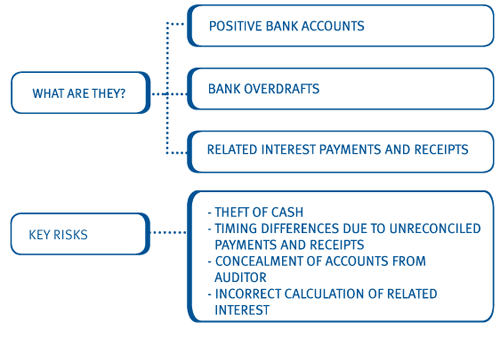
Key assertions
- Existence â€" cash and bank balances really exist;
- Rights and obligations â€" the visitor has rights to receive the benefit from those balances;
- Valuation and allocation â€" balances are included in the financial statements at the correct corporeality;
- Completeness â€" all balances have been accounted for.
- Nomenclature and understandability â€" balances are accordingly disclosed in the financial statements?
The depository financial institution letter of the alphabet
- This is a direct confirmation of banking concern balances from the bank that gives the auditor independent, third-political party evidence.
- The format of the letter is unremarkably standard and agreed between the banking and auditing professions.
- Problems covered are:
- the client’s proper name
- the confirmation date
- balances on all depository financial institution accounts held
- whatever documents or other assets held for safekeeping
- details of whatever security given
- details of whatsoever contingent arrangements â€" guarantees, forward currency purchases or sales, letters of credit.
- The auditor needs the client to give the bank say-so to disclose the necessary information (in some jurisdictions such disclosures are illegal so bank letters cannot be used at all).
- Ensure that all banks that the client deals with are circularised.
- The balances for each business relationship should be agreed to the relevant depository financial institution reconciliation at the year stop;
- Details of loans should be agreed to the disclosure in the statement of financial position as either electric current or non-electric current.

 Example bank confirmation letter
Example bank confirmation letter
Whites & Harper Inc.
14 The Grove
Kingston
KI4 6AP
Director (Audit Confirmations)
National Depository financial institution Anytown Co-operative
High Street, Anytown
AT1 1HS
1 January 20X1
Dearest Sir,
Re: Blakes Co.
In accordance with the agreed practice for provision of data to auditors, please forward data on our mutual client as detailed below on behalf of the bank, its branches and subsidiaries. This request and your response will not create any contractual or other duty with u.s.a..
Company name: Blakes Co.
Main account number: 01789311
Sort code: 4-83-12
Information required

- Derivative and article trading
- Custodian arrangements
- Other information (encounter attached)
Audit confirmation date: 31/12/X0
The Authority to Disclose Data signed by your customer is already held past y'all. This is dated thirty/08/X0. Please advise us if this Authority is insufficient for you to provide full disclosure of the data requested.
The contact name is: James Hodges (Audit Partner)
Phone: 01234 123456
Yours Faithfully,

Whites & Harper Inc.

Bank and cash â€" other evidence
- Obtain a list of all bank accounts, cash balances and depository financial institution loans and overdrafts and concur to totals to figures included in current assets and current liabilities in the financial statements.
- Obtain a copy of the client'southward bank reconciliation, cast and agree the balances to the cash book and depository financial institution alphabetic character.

 Example banking concern reconciliation
Example banking concern reconciliation
Banking company reconciliation as at 31 Dec 20X0


- Trace all outstanding lodgements and unpresented cheques to pre-yr-end cash book and postal service-twelvemonth-end bank statements.
- Ensure all accounts in the bank letter are included in the financial statements.
- Ensure bank loans and overdrafts are not kickoff against positive bank balances in the financial statements.
- Count the petty cash in the cash tin can at the end of the year and concord the total to the balance included in the fiscal statements.
Presentation and disclosure
- Inspect the typhoon financial statements and ensure that amounts are disclosed correctly as either assets (positive balances) or liabilities (overdrafts) and that the amounts recorded agree to the nominal ledger.
7 The audit of tangible non-current assets

Central assertions
- Being â€" assets actually exist;
- Rights and obligations â€" the visitor has rights to receive the do good from those avails;
- Valuation and allocation â€" assets are included in the financial statements at the correct corporeality;
- Completeness â€" all assets accept been accounted for.
- Nomenclature and understandability â€" avails are appropriately disclosed in the fiscal statements?
Existence
- Select a sample of assets from the non-electric current asset register and physically inspect them.
Completeness
- Select a sample of assets visible at the client bounds and audit the asset register to ensure they are included.
- Examine the repairs and maintenance accounts in the general ledger for large and unusual items that may be capital in nature. These should be included in the statement of fiscal position, not expenses.
Valuation
- Cast the non-electric current asset register to ensure arithmetical accuracy.
- Recalculate the depreciation charge for a sample of assets.
- Analytically review depreciation charges in comparison to the prior year.
- Perform a proof in total by adjusting the prior year figure for all additions, disposals and revaluations and then calculating total depreciation based upon this figure.
- Compare depreciation methods and policies in comparison to the previous year to ensure consistency.
- If any assets have been revalued during the year:
- agree new valuation to valuer’s study
- verify that all avails in the aforementioned class have been revalued
- reperform depreciation calculation to verify that accuse is based on new carrying value.
- When physically inspecting assets, take note of their condition and usage in instance of damage.
- For a sample of nugget additions, agree the toll to purchase invoices (or other relevant documentation).
- If any assets have been constructed by the company, obtain analysis of costs incurred and agree to supporting documentation (timesheets, materials invoices, etc.).
Rights and obligations
- For a sample of recorded assets, obtain and audit ownership documentation:
- title deeds for properties
- registration documents for vehicles
- insurance documents may likewise aid to verify ownership (and nugget values).
- Where assets are leased, inspect the lease document to assess whether the lease is operating or finance (if the latter, the nugget should be included on the company’s statement of financial position).
Disclosure
- Hold opening balances with prior yr financial statements.
- Compare depreciation rates in use with those disclosed.
- For revalued assets, ensure appropriate disclosures fabricated (e.g. name of valuer, revaluation policy).
- Concord breakdown of assets betwixt classes with the general ledger account totals.
8 The audit of share upper-case letter, reserves and directors' remuneration
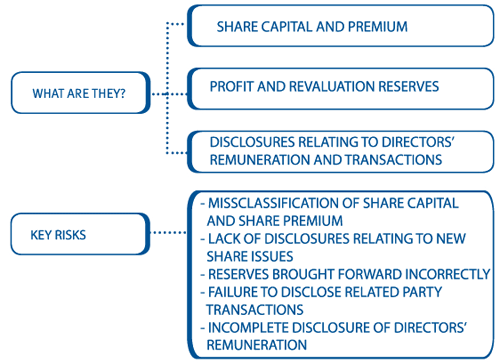
 Directors' remuneration is a cardinal audit surface area as information technology is invariably textile by nature.
Directors' remuneration is a cardinal audit surface area as information technology is invariably textile by nature.
Central assertions
- Existence â€" practice share capital balances and reserves actually exist;
- Rights and obligations â€" the company has obligations regarding equity balances;
- Valuation and allocation â€" equity is included in the financial statements at the correct amount;
- Completeness â€" all equity balances, directors' remuneration and other transactions with directors accept been accounted for.
- Nomenclature and understandability â€" relevant disclosures accept been made in the financial statements, particularly with regard to directors' remuneration.
Share uppercase
- Agree authorised share capital and nominal value disclosures to underlying shareholding agreements, such as company memorandums, articles of clan and lists of registered members;
- Inspect cash book for evidence of cash receipts from share problems;
- Audit terms of share certificates and reconcile to cash receipts and new share uppercase totals;
- Inspect board minutes to identify if any dividends have been declared prior to the year-stop;
Directors' remuneration
- Reconcile reported directors' salaries to payroll records;
- Audit lath minutes for bear witness of directors' bonus announcements;
- Reconcile directors' bonuses to greenbacks payments in the cash book;
- Inspect board minutes for approving of related party transactions;
- Obtain a written representation from directors that they have disclosed all related party transactions and managing director remunerations to the auditor.
Reserves
- Reconcile endmost profit reserves to: opening reserves, profit for the year and dividend paid and proposed during the twelvemonth;
- Compare opening reserves to endmost reserves reported in the prior year'due south fiscal statements;
- Reconcile movements in revaluation reserves to the non-electric current asset register;
- Corroborate revaluations by comparing to independently produced reports.
9 Accounting estimates
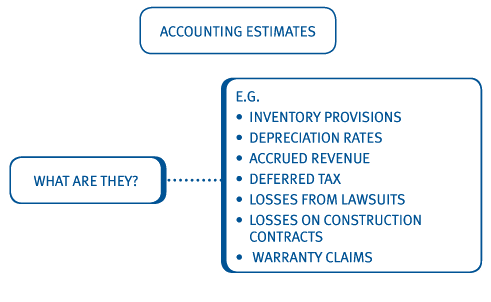
Accounting estimates are of particular business organisation to the auditor as, by their nature, there may not be any concrete evidence to support them and they are prone to inaccuracy. They are also subjective and therefore prone to management bias. If the directors wished to dispense the accounts in any way, accounting estimates are an easy way for them to practise this. The accountant must take care when auditing estimates to ensure this has not been the case.
In accordance with ISA 540 Auditing Bookkeeping Estimates auditors need to obtain an understanding of:
- How management identifies those transactions, events and conditions that give rise to the need for estimates; and
- How direction actually makes the estimates, including the control procedures in place to minimise the risk of misstatement.
ISA 540 besides requires the accountant to:
- Evaluate the degree of uncertainty associated with an accounting guess; and
- Consider if estimates with a high degree of uncertainty give rising to significant risks.
In response to this assessment auditors should perform the following farther procedures:
- Review of the outcome of the estimates fabricated in the prior period (or their subsequent reestimation);
- Consider events after the reporting date that provide boosted evidence nigh estimates fabricated at the twelvemonth-end;
- Test the basis and data upon which direction made the estimate (eastward.g. review mathematical methods);
- Exam the operating effectiveness of controls over how estimates are made;
- Develop an independent guess to use equally a point of comparison; and
- Consider whether specialist skills/knowledge are required (e.thou. lawyer).

 Smaller entities
Smaller entities

Smaller commercial entities volition usually have the in a higher place attributes. This tin can lead to both advantages and disadvantages:
- Lower chance: Smaller entities may well exist engaged in activity that is relatively simple and therefore lower risk. However, this will not be true for minor â€" often 1 person businesses â€" where at that place is a loftier level of expertise in a particular field, eastward.k. consultancy businesses, creative businesses, the fiscal sector.
- Direct control by owner managers is a strength because they know what is going on and have the ability to exercise real control. They are also in a strong position to manipulate the figures or put private transactions ‘through the books’.
- Simpler systems: Smaller entities are less likely to take sophisticated Information technology systems, simply pure, manual systems are becoming increasingly rare. This is good news in that many of the bookkeeping errors associated with smaller entities may at present exist less prevalent. However, a system is just as skillful as the person operating information technology.
Evidence implications
- The normal rules apropos the relationship betwixt risk and the quality and quantity of show apply irrespective of the size of the entity.
- The quantity of evidence may well be less than for a larger organisation.
- It may be more efficient to carry out 100% testing in a smaller system.
Problems
- Direction override â€" Smaller entities will take a key director or director who will have pregnant ability and authority. This could mean that controls are lacking in the outset place or they are easy to override.
- No segregation of duties â€" Smaller entities tend to have few accounts clerks that processes information. To overcome this the directors should authorise and review the all piece of work performed.
- Less formal approach â€" Smaller entities tend to accept unproblematic systems and very few controls due to the trust and the lack of complexity. It is therefore difficult to test the reliability of systems and substantive testing tends to exist used more.


 Non-for-profit organisations
Non-for-profit organisations
Non for profit (NFP) organisations include charities and public sector entities. The most important differences from privately owned companies are that NFP entities:
- exercise non have profit maximisation as their main objective. These volition be either social or philanthropic;
- do not have external shareholders; and
- volition non distribute dividends.
Potential problems auditing a NFP entity
Some NFP entities, particularly small charities, may have weaker systems due to:
- lack of segregation of duties, every bit the organisation will be restricted with the amount of staff;
- the apply of volunteers, who are likely to be unqualified and have little awareness of the importance of controls;
- the use of less formalised systems and controls.
Significantly, with many charities, much of the income received is by way of donation. These transactions will not exist accompanied by invoices, orders or despatch notes.
Assessing the going concern of a NFP entity may also exist more difficult, particularly for charities who are reliant on voluntary donations. Many issues, such every bit the state of the economy, could affect on their ability to generate acquirement in the short term.
Audit implications
Auditors of not for profit organisations will exist required to assess whether the aims of the organisation are being met in an economic, efficient and effective manner. For this reason "value for money" audits are much more appropriate. These are discussed in more detail in the internal inspect chapter.
Testing tends to concentrate on substantive procedures where control systems are lacking. In the absence of documentary show procedures rely heavily on analytical review, enquiry and direction representation.
The volumes of transactions in not for profit organisations may be lower than a private i, therefore auditors may be able to test a larger % of transactions.
Ultimately, if sufficient advisable bear witness is non bachelor the auditor volition accept to modify their inspect study.


 Test your understanding one
Test your understanding one
Listing and explicate FOUR assertions from ISA 315 Identifying and Assessing the Take a chance of Material Misstatement Through Understanding the Entity and its Surround that relate to the recording of classes of transactions.
| Existent exam question: June 2009 | (4 marks) |


 Examination your agreement 2
Examination your agreement 2
Listing 4 assertions relevant to the audit of tangible not-electric current assets and land ane audit process which provides advisable testify for each assertion.
| Real examination question: December 2008 | (4 marks) |


 Exam your understanding 3
Exam your understanding 3
(a)Define 'tests of command' and explicate why they are an important procedure in the statutory inspect of any company.
(4 marks)
You lot are an audit senior working at a medium sized firm of auditors. One of your clients is an sectional hotel called ‘Numero Uno’ situated in the centre of Big City. As part of your audit procedures you are assessing the controls surrounding payroll. You accept read last year’s audit file and have obtained the following information:
The hotel employs both full and part fourth dimension staff. Due to the nature of the business near of the work is done in shifts. All staff are paid on a monthly footing.
New members of staff are given an electronic photo identification carte on the day they join by the personnel department. This card is used to ‘clock in’ and ‘clock out’ at the start and end of the shift to record the hours worked.
At the cease of each week the data recorded on the organization is sent automatically to the payroll department and besides to the head of each of the three main operating divisions: Rooms, Food & Beverage and Corporate Events. Each segmentation caput must reply back to the payroll department by email to authorise the hours worked by their staff.
The payroll clerk collates all the authorised information and then inputs the hours worked into a standardised computerised payroll parcel. This system is countersign protected using an alphanumerical password that but the payroll clerk and the finance director know.
One time the hours have been inputted, the calculations of gross pay and taxation are calculated automatically along with any other statutory deductions. At the end of the calculations a payroll report is produced and printed. The finance managing director reviews the report and compares the data to final month to identify and follow up any unusual variances. When he is satisfied with the data he authorises the payroll run by signing the payroll report and the payroll clerk submits the data.
Payslips are sent to the dwelling address of each employee and payment is made past bank transfer.
‘Numero Uno’ prides itself on delivering a commencement class dining experience and is renowned for its standards of service and cooking that few restaurants in the country come up close to. Its inventory therefore consists of the very best foods and beverages from across the globe.
Food products held in inventory are by and large fresh as the head chef will only work with the very best ingredients. ‘Food’ inventory is stored in the kitchens and managed by the head chef himself.
The majority of beverages held at the hotel are expensive wines that accept been sourced from sectional vineyards. The hotel also stocks a wide range of spirits and mixers. All beverages are stored either in the hotel cellar or behind the bar. The cellar tin can only exist accessed by the duty director who holds the key. As office of your inspect procedures you volition attend the yr cease inventory count of the hotel’s beverages.
Required:
(b)With reference to the scenario:
(i) Identify and explicate Iv STRENGTHS within the hotel’south internal control arrangement in respect of payroll.
(6 marks)
(ii) For each of the identified strengths, state a test of control the accountant could perform to assess if the controls are operating effectively.
(four marks)
(c)Describe the inspect procedures an auditor would conduct before and whilst attending the inventory count of the beverages in the hotel.
(8 marks)
(d)Place and explain THREE fiscal statement assertions that are most relevant to inventory.
(three marks)
(east)Autonomously from attention the inventory count, describe the substantive procedures an auditor would carry out to confirm the valuation of the wine and spirits held in inventory at the year end.
(5 marks)
(Full: thirty marks)


 Test your understanding four
Test your understanding four
(a)Depict the steps an auditor should take when conducting a merchandise receivables confirmation (circularisation) examination.
(iv marks)
(b)Explain why a straight confirmation exam may not provide sufficient appropriate audit evidence on its ain.
(three marks)
You are the audit managing director in charge of the audit of Builders Mate, a limited liability company. The company’s year stop is 31 March, and Builders Mate has been an audit client for three years. Builders Mate sells small tools, institute and equipment exclusively to the building trade. They have 12 warehouse mode shops located throughout the state. Builders Mate does not manufacture any products themselves.
The audit fieldwork is due to embark in 3 weeks time and you are preparing the audit work programme for the trade receivables section of the audit. Extracts from the clients trial balance show the following information.

From your review of final year’s audit file you lot have determined that concluding year there were two specific provisions of $5k and $2k too as a three% general provision.
Initial conversations with the customer indicate that there are no specific provisions that are to exist made this year however they intend to reduce the general provision from 3% to 2%.
You are aware that two of Builders Mate’southward major customers went into administration during the yr and they are likely to be liquidated in the near time to come. Both of these customers owed textile amounts at the yr-end.
Required:
(c)Describe substantive procedures the accountant should perform on the year-cease trade receivables of Builders Mate.
(9 marks)
(d)Describe how audit software could facilitate the inspect of trade receivables.
(Total: 20 marks)

10 Chapter summary

Examination your understanding answers

 Test your understanding 1
Test your understanding 1
Assertions: classes of transactions
- Occurrence: The transactions and events that have been recorded have really occurred and pertain to the entity.
- Completeness: All transactions and events that should have been recorded have been recorded.
- Accuracy: The amounts and other information relating to recorded transactions and events have been recorded appropriately.
- Cut-off: Transactions and events have been recorded in the correct accounting menstruum.
Nomenclature. Transactions and events have been recorded in the proper accounts.


 Test your understanding 2
Test your understanding 2
Tangible non-current assets: assertions
- Completeness: ensure that all non-current avails are recorded in the non-current asset register by like-minded a sample of assets physically verified back to the annals.
- Being: ensure non-current assets exist by taking a sample of avails from the register and physically seeing the nugget.
- Valuation and allocation: ensure avails are correctly valued by checking the reasonableness of depreciation calculations.
- Rights and obligations: ensure the company owns the asset by seeing appropriate document of buying for example, a purchase invoice.
- Presentation and disclosure assertions: ensure all necessary fiscal statements disclosures take been made by reviewing the financial statements.
Note: Simply 4 assertions were required.


 Exam your agreement 3
Exam your agreement 3
(a)Tests of control
A test of control tests the operating effectiveness of controls in preventing, detecting or correcting cloth misstatements.
Information technology is important for the external auditor to examination controls to ensure their initial understanding obtained when assessing the control surround and internal controls is advisable.
This will allow the auditor to identify and appraise the risks of material misstatements in the financial statements and to determine to what extent to rely on the internal control organization during the inspect.
The auditor will then exist able to design sufficient and appropriate noun audit procedures to reduce detection run a risk, and therefore audit risk, to an adequate level.
(b)Payroll organization strengths and tests of command
Strengths in the control surroundings at the hotel in respect of payroll are set out below including the exam of control to be performed past the auditor.
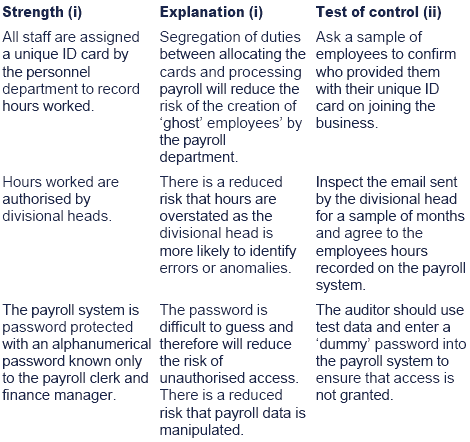
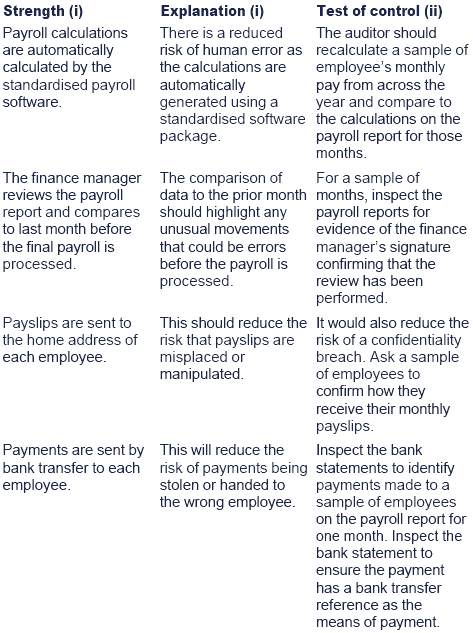
(c)Procedures earlier the count
- Review prior yr working papers to sympathise the inventory count process and identify whatever issues that would need to be taken into account this yr.
- Contact Numero Uno (client) to obtain stocktaking instructions for this yr to empathize how the count will be conducted and assess the effectiveness of the count process.
- Book audit staff to attend the inventory count.
- Ascertain whether any inventory is held by tertiary parties and if applicative determine how to gather sufficient audit evidence.
- Consider the demand for using an skilful to assist in valuing the inventory being counted. There may be some speciality wines and spirits that crave adept valuation.
During the count
- Observe the count to ensure that the instructions are existence followed.
- Inspect the bottles being counted for evidence of harm or obsolescence that may impact the cyberspace realisable value and hence overall valuation of inventory.
- Perform a test count. Select a sample of beverages from the inventory count sheets and physically observe the items in the cellar or bar to confirm they exist.
- Perform a test count. Select a sample of physical beverages from the cellar or bar and trace to the inventory count sheets to ensure that they are recorded accurately and therefore that the records are consummate.
- Record cut off data by obtaining details of the final deliveries prior to the year stop. This data will be used in final audit procedures to ensure that no farther amendments have been made thereby overstating or understating inventory.
(d)Inventory assertions
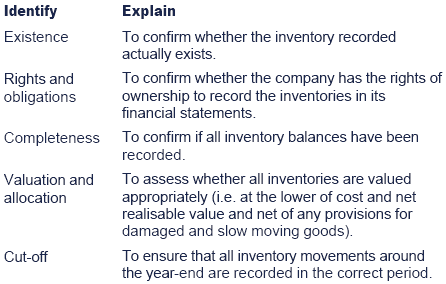
(e)Substantive procedures
Quantity
- For the audit test counts performed during the inventory count trace and agree the quantities to the concluding inventory records to ensure the integrity of the data.
The beverages should be valued at the lower of toll and net realisable value.
- For a sample of beverages on the inventory records, trace the cost of those items to the original purchase invoice, ensuring that the description of appurtenances on the invoice matches the beverage.
- For beverages sold to customers after the year end, check a sample of eatery bills/invoices back to the terminal inventory records ensuring that the sales value exceeds the toll. Where sales value is less than cost, ensure that the beverage is stated at the realisable value.
- For high value items such every bit Champagne, vintage wine and exotic spirits use an adept valuer to review the cyberspace realisable value of a sample of items to ensure the value is reasonable.
- Inventory noted during the count as maybe obsolete or damaged should be traced to the inventory records to ensure the valuation has been adapted to accept this into account. The expert valuer may provide assistance with these valuations.


 Exam your understanding 4
Exam your understanding 4
(a)Trade receivables circularisation
Several steps should be performed past an auditor when performing a trade receivables circularisation audit test:
- Audit client approval should be obtained in advance to perform the direct confirmation test of trade receivables.
- The population for the sample should be determined and a suitable sample selected using an appropriate sampling technique.
- The confirmation alphabetic character should be designed and prepared for each receivable ensuring the contact details are right and return details conspicuously state that the reply should be made direct to the auditor.
- A business organisation reply envelope, addressed to the accountant, could be included for this purpose.
- The sending of letters, including whatever follow-upwards requests, should be controlled and performed by the auditor to ensure the integrity of the examination.
- Replies should be matched or reconciled to the audit client’s receivables accounting records.
- Alternative inspect procedures will be required for all not-responses to the confirmation letter.
(b)Sufficiency of the testify from a direct confirmation test.
Several factors influence the sufficiency of evidence gathered during a direct confirmation of trade receivables and other show may be required past an accountant to class an opinion in this area:
- There is ofttimes a depression response rate from trade receivables pregnant that other audit procedures will be required for these balances.
- The type of confirmation letter of the alphabet, whether a positive or negative confirmation request, will influence the sufficiency of evidence gathered. Negative confirmations provide less persuasive audit evidence than positive confirmations and it is unlikely that a negative confirmation will provide sufficient evidence on its own.
- The reliability of the responses to the confirmation requests may be in doubt for example if there is a risk of fraud being perpetrated.
- Mistakes and errors may exist present in the accounting records of the trade receivables confirming the balance outstanding.
(c)Substantive procedures for trade receivables.
- Trace and concord the receivables balances on the trial balance to Builders Mate’due south accounting system and the draft financial statements.
- Confirm the trade receivables command account balance matches the sum of the individual trade receivables ledger accounts.
- For a sample goods dispatched notes around the year-end trace to the sales invoice and ledger accounts to ensure that the transactions have been recorded in the correct accounting menses.
- Cast a sample of merchandise receivable ledger accounts to ostend arithmetical accuracy.
- Select a sample of individual trade receivables and perform a straight confirmation test using a positive confirmation letter.
- For not-responses to the direct confirmation test ostend greenbacks has been received postal service yr-cease for the outstanding amounts.
- Cash receipts recorded in the trade receivables ledger account should be traced and agreed to their remittance advice likewise equally the cash book and banking concern statements.
- Recalculate the general provision based on the 2% figure to ensure arithmetical accuracy.
- Discuss with the Builders Mate management why the general provision has reduced from 3% to 2% and assess the reasonableness of the explanations provided.
- Obtain or prepare an aged receivables analysis to place aged debts that may crave a specific provision. Talk over with management any such balances and ensure specific provisions are made if appropriate.
- Trace and confirm that the specific provisions fabricated in the prior year were either written off or the cash was recovered in the current accounting menstruum.
- Discuss with direction the reason for not making specific provisions for the two customers in administration who owe textile amounts at the year-end.
- Consider and discuss with management the potential implications of failing to make specific provisions on the audit opinion.
- Compare a sample of individual trade receivables to their prior yr rest and investigate any unusual or unexpected changes between the balances.
(d)Inspect software
Audit software can be used to ameliorate the effectiveness and efficiency of the audit process of trade receivables.
- Audit software tin can be used to prepare an anile receivables assay and to identify potential irrecoverable debts using a range of criteria set past the auditor.
- It tin analyse the receivables ledger for credit balances or negative balances.
- Inspect software will be more efficient and accurate at casting and recalculating figures, totals and balances such as the full general provision or casting of the receivables ledgers.
- It could besides select a sample for testing and prepare direct confirmation letters.


| Created at 5/24/2012 two:38 PM by Arrangement Account (GMT) Greenwich Mean Time : Dublin, Edinburgh, Lisbon, London |
Final modified at 10/4/2012 8:36 AM by System Business relationship (GMT) Greenwich Mean Time : Dublin, Edinburgh, Lisbon, London
| |
| |

 |
Rating : |  Ratings & Comments (Click the stars to charge per unit the page) Ratings & Comments (Click the stars to charge per unit the page) |
 |
Tags: | |




![]() Linking assertions to tests
Linking assertions to tests

![]() A farther warning
A farther warning

![]() Also annotation the effect of directional testing, e.g. direct testing receivables for overstatement also indirectly tests acquirement for understatement (Dr: Receivables, Cr: Revenue).
Also annotation the effect of directional testing, e.g. direct testing receivables for overstatement also indirectly tests acquirement for understatement (Dr: Receivables, Cr: Revenue). 
![]() Case confirmation letter
Case confirmation letter



![]() Again, note the upshot of directional testing, e.g. directly testing payables for understatement likewise indirectly tests expenses/cost of sales for understatement (Dr: Expenses/Cost of sales, Cr: Payables).
Again, note the upshot of directional testing, e.g. directly testing payables for understatement likewise indirectly tests expenses/cost of sales for understatement (Dr: Expenses/Cost of sales, Cr: Payables).
![]() Supplier statements
Supplier statements


![]() Example bank confirmation letter
Example bank confirmation letter



![]() Example banking concern reconciliation
Example banking concern reconciliation



![]() Directors' remuneration is a cardinal audit surface area as information technology is invariably textile by nature.
Directors' remuneration is a cardinal audit surface area as information technology is invariably textile by nature.

![]() Smaller entities
Smaller entities


![]() Non-for-profit organisations
Non-for-profit organisations

![]() Test your understanding one
Test your understanding one

![]() Examination your agreement 2
Examination your agreement 2

![]() Exam your understanding 3
Exam your understanding 3

![]() Test your understanding four
Test your understanding four



![]() Test your understanding 1
Test your understanding 1

![]() Test your understanding 2
Test your understanding 2

![]() Exam your agreement 3
Exam your agreement 3




![]() Exam your understanding 4
Exam your understanding 4
![]()
![]()
![]()
 Ratings & Comments (Click the stars to charge per unit the page)
Ratings & Comments (Click the stars to charge per unit the page) ![]()
![]()
0 Response to "Which of the Following Might Be Detected by an Auditorã¢â‚¬â„¢s Review of the Clientã¢â‚¬â„¢s Sales Cutoff?"
Post a Comment